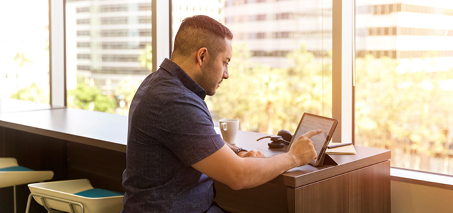How to be super productive when working from home
How can you tackle the unique challenges that come with working in the comfort of your own home, whilst ensuring you’re as productive as possible?
I myself, am a seasoned remote worker, and tend to work from home on busy days like Mondays, Tuesdays and Thursdays.
At the present time, the challenge of ensuring high levels of productivity when working remotely is a very real one for many around the world, regardless of role or, indeed, the size of the business they work in. Promisingly, however, many have managed to crack the code, and are reaping the rewards, which I will be exploring in this blog.
Four ways to maintain your productivity when working from home, or remotely
With home working seemingly becoming a trend which is here to stay, at least for the foreseeable future, working productively from remotely is a skill that most of us must master. So, I’ve put together some tips to help you become super productive, based on my experience at Empact Ventures and that of others I work with from disruptive founders, corporate leaders and even those working in the non-profit sector.
1. Establish a productive work routine at home
For many home workers, the lack of a structured 9-5 working day can lead to issues with motivation and even over-working, while struggling to set boundaries between work and home life. It is all too easy to start working early, thus adding an extra couple of hours onto your working day. Likewise, there is no one to raise an eyebrow if you sleep through your alarm and log into your computer a few minutes late.
Remote workers also miss out on the in-built structure that breaks up the working day – from the commute, to the coffee breaks, to taking lunch and scheduled meetings. So, here are a few ways you can instate a routine to your day when working from home, and boost your productivity in the process:
- Whilst you don’t have to mirror the daily routine of an office in your own home, boundaries are essential. So, prepare for the day by dressing professionally every morning, then jot down the key tasks that need to be achieved that day so that you can focus your mind and prioritise your workload. You will also experience a sense of achievement and motivation each time you’re able to tick a task off your list.
- Replace your morning and evening commute with a short walk that allows you to focus your mind on the day ahead. Studies have found that taking short walking breaks outside can aid productivity and reduce the impact of stress. Meditation can also help to focus your mind and block out all distractions in the room to enable you to focus.
- Buffer’s State of Remote Work 2019 report found that 22 per cent of remote workers struggle to unplug. So, always ensure that you start and finish your working day at approximately the same time and try to schedule your breaks for the same time each day. Being proactive in maintaining a good work-life balance, even when you are working in the same place you’re living, is crucial to maintaining your productivity.
Of course, everyone is different, and all home workers will ultimately follow their own version of this routine. As you spend more time working from home, try to be aware of the specific things that you find distracting or that negatively impact your ability to focus and be productive. For instance, if your energy tends to drop in the mid-afternoon, keep some healthy snacks by your desk or plan a short walk for this time. You will soon figure out a system that works as well as, or even better for you than your office routine.
2. Use technology to collaborate and communicate more productively
According to Buffer’s State of Remote Work 2019 report, 17 per cent of remote workers struggle to collaborate with their colleagues – which has a huge impact on their ability to be productive. However, there are plenty of ways to improve how you connect and collaborate (thus boosting your productivity) without physically sitting next to your colleagues. Keep in touch with your workmates by using chat channels such as Slack, or co-operative apps such as Asana. Video-enabled options such as Skype, GoToMeeting and HipChat can add a visual element to remote meetings or project updates, making your team feel closer even if everyone is working in a different location.
A word of warning though – not all technology is your friend when you work from home. Social media, gaming apps and television can all affect your productivity by distracting you and breaking your flow. If this is an issue for you, turn off all non-essential tech products during working hours.
At Empact Ventures, traditionally, our team works remotely from home or from different cities around the UK around 50 per cent of the time, and technology can play a big role in collaboration. We use Google Apps for working on documents together, Google Hangouts for video and voice calls, share audio recordings to circulate information that doesn’t require a call, and use other tools like Trello to organise ourselves.
It’s also important to remember that different approaches and tools work best for different companies, and indeed, for different individual employees when it comes to collaborating productively when working remotely. One thing that is consistent, however, is the need for a defined process. Gunnar Bless, co-founder, and CEO of Zasteo, shares his thoughts, “To achieve a high level of productivity in a remote situation processes are quite important. This starts with establishing a set of tools that facilitate people to communicate and to coordinate their work. But it also entails making sure that communication does actually happen, be it via team-meetings, an integration process on the software side or other check-in points. It is, of course, important to keep the motivation up, particularly during challenging times like these, so regular virtual meetings face to face and social activities together also play an important part for us.”
3. Tackle any feelings of isolation you may have when working remotely
Many people love the peace and quiet that comes with working from home, as it allows them to focus and potentially be more productive. However, according to Buffer, 19 per cent of remote workers say they struggle with loneliness. According to recent research from OWL Labs, 48 per cent of home workers miss the conversations that they have in the office; while 40 per cent miss workplace celebrations and 34 per cent miss the culture of the office.
Feelings of loneliness and isolation can have a knock-on effect on our productivity. After all, as explained in this Hays Journal article, feeling as though we belong is one of our most basic, primal needs. If we’re working away from our colleagues, on our own, day in day out, it can be hard to feel part of a wider team and feelings of isolation or loneliness can creep in.
So, when you work from home, try to start each day with a phone call or a face-to-face video meeting, so that you don’t miss out on this important part of your working life. Use video conferencing when possible to help develop a connection with your co-workers. Keep track of your colleagues’ birthdays and make a point of sending them a note or giving them a call so that they know you’re thinking of them. These efforts will not go un-noticed and will help you to stay close with your team while benefitting from the psychological and professional benefits of your work friendships, including increased productivity and keeping loneliness at bay.
It’s also important to try to be proactive in initiating virtual face-to-face communication both with work colleagues and your wider network, as Susan Kabani, UGenie‘s co-founder and CEO explains: “Working remotely, especially as a start-up founder, can be very lonely. Luckily, digital technology has made it so much easier to stay connected. Even before the current crisis, we used Zoom, Ugenie, and Slack to communicate with our team, clients and partners. Over the past few weeks, these technologies have helped a wide range of businesses stay connected and supported through a very unprecedented time. Although I am a big fan of meeting people in real-life, these online meetings and events have been a wonderful, and very efficient way to stay connected with people.”
4. Optimise your home working environment
Modern offices are designed to be as work-friendly as possible, with ergonomic seating, calming colours, and designated break areas. And while there may be a limit to how much of this you can recreate at home, there are a few shortcuts to a productive workspace.
Try to create a little office for yourself in your home, whether that’s a separate room that no one can come into, or a place at the dinner table that is just yours. It is important to avoid sitting on sofas or beds when working, as this can lead you to not focus as you would normally in an office.
If you live on a busy street, consider investing in some good noise-cancelling headphones, which is what I invested in recently, so you don’t have to listen to beeping horns and revving engines all day. Alternatively, if you are struggling with a ‘too quiet’ environment, play music on a low volume to create a background hum – Baroque and ambient music are said to be particularly good for concentration.
To mimic the spacious feel of a modern office, keep furnishings and clutter to a minimum. It might also be a good idea to paint your office walls in uplifting shades of blue, white or green – green is said to promote concentration. Add a few houseplants to improve your air quality, lift your mood and boost your productivity – little touches like this will help make your home office a relaxing and productive space.
Invest in a good chair, gel wrist supports at your desk, a second computer screen that is kept at eye height, and a raised keyboard. These will help to reduce the risk of desk-based problems such as repetitive strain injury (RSI), while creating a comfortable workspace that aids productivity.
Commit to working in your home office, and only in your home office. This is harder than you might think when you have your entire home at your disposal, but if you bring your work into the living room or – worst of all – the bedroom, you will soon find that your work life and home life blend into one. This will make it harder to switch off in the evening and motivate yourself to start work in the mornings – all negatively impacting on your productivity.
Finally, it’s important to understand that different home working environments will work best for different people. So take time to understand what suits you best, as Kabani explains: The key to setting up a productive office is understanding what works for you. For my co-founder, he needs a very distinct space that separates home and work. Even on a Saturday, prior to the COVID-19 pandemic of course, he needs to go to a quiet room at home to be most productive. For me, I am most productive when I’m most comfortable. As long as I have a good Wi-Fi connection, a good power point, my laptop and some coffee, I’m happy.”
Working from home or remotely doesn’t mean that you have to become isolated from your colleagues and the wider workforce; at the mercy of myriad distractions and household pressures – leading to a decline in your productivity. Far from it. In fact, by creating a positive workspace, sticking to a routine, developing relationships with your colleagues and taking advantage of the latest new technology, you can ensure your productivity soars when working from home.





